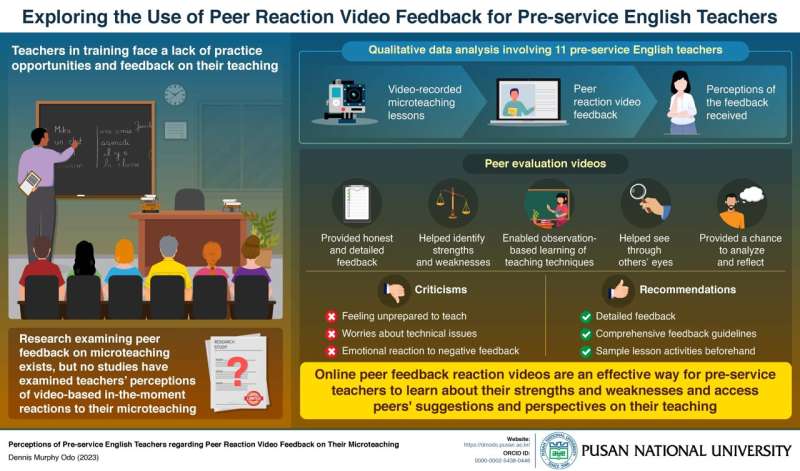This article has been reviewed according to Science X's editorial process and policies. Editors have highlighted the following attributes while ensuring the content's credibility:
fact-checked
peer-reviewed publication
proofread
Study examines the perceptions of pre-service teachers on peer reaction video feedback

Teacher training courses are integral to teacher education programs. However, they often offer limited opportunities for novice teachers to practice teaching and receive feedback on their performance. In this regard, peer evaluation of a teacher's recorded teaching video or "microteaching" is promising. Recently, this method has been integrated into many teacher education programs.
Analyzing a peer's performance can allow trainee teachers to gain a deeper understanding of their own teaching practice while providing inexperienced teachers with exposure to a broader range of teaching scenarios before starting their professional careers. However, most studies investigating the efficacy of online microteaching videos have focused on an instructor giving feedback to their student rather than peer video reaction feedback.
Now, however, a new study by Professor Dennis Murphy Odo from Pusan National University seeks to fill this gap. The study, made available online in SAGE Open, involved 11 pre-service English teachers recruited from a national university in South Korea, each of whom filmed themselves presenting a 20-minute microteaching lesson.
The recorded videos were sent to a course instructor and their peers, who then separately recorded themselves watching and reacting to the video lesson. Lastly, the pre-service teachers were given the peer reaction video recordings and asked to fill out a questionnaire on their perceptions regarding the feedback they received.
The analysis of the collected qualitative data revealed promising results. The participants felt that they learned a lot about teaching by watching and providing feedback on their peers' video lessons. The reaction videos provided them with helpful feedback on the strengths and limitations of their lessons and an opportunity for objective evaluation of their own performance. Furthermore, this process provided trainees with various perspectives on their teaching and allowed them to see themselves through the eyes of others, which could enhance their reflection skills.
Another benefit of peer reaction video feedback was the ability to provide more concrete feedback on the trainees' performance. It also enabled the person receiving feedback to see the context of the lesson addressed by the feedback. Some participants also felt that the video format encouraged more honest feedback than that received in a face-to-face feedback session.
"The method likely created some psychological distance between the receiver and the giver of the feedback, and this helped reduce the discomfort and potential damage in delivering the feedback," says Prof. Odo.
However, participants also identified a few downsides to this method. For instance, some trainees felt that they were not prepared to properly conduct a video feedback assignment and needed more guidance. In addition, the potential for technical difficulties worried some participants and an authentic classroom experience could not be recreated due to the lack of interaction between the feedback provider and receiver. Moreover, some participants felt that it was difficult to share negative feedback, even over video, because of its potential to harm relationships and elicit sensitive reactions to critical comments.
Furthermore, the study also brings forth a range of suggestions to improve the practice of peer reaction video feedback. It emphasizes the need for comprehensive feedback using more detailed feedback guidelines, such as prescribing a minimum number of comments and sampling lesson activities in advance to improve the peer feedback experience for pre-service teachers.
The findings thus suggest that teacher training programs can incorporate peer feedback reaction videos as a standard component of their curriculum to enhance self-reflection and improve teaching skills among trainee teachers. "Integrating this method in practice could lead to a generation of teachers who are more self-aware, receptive to feedback, and flexible enough to adapt their teaching methods to meet the needs of their students. This could, in turn, lead to improved student outcomes, increased engagement in the classroom, and a more positive learning environment overall," concludes Prof. Odo.
More information: Dennis Murphy Odo, Perceptions of Preservice English Teachers Regarding Peer Reaction Video Feedback on Their Microteaching, SAGE Open (2023). DOI: 10.1177/21582440231210652
Journal information: SAGE Open
Provided by Pusan National University





















